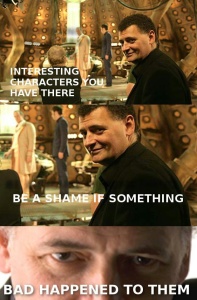
I’ve missed a Thursday or three in my weekly posts the last few months. I should be flogged for that. I’ll probably have to find anorther writer to perform said flogging. Why?
Writers are sadists.
Well, most writers are sadists. Well, closet sadists. (Hear me saying that as the 10th Doctor?)
I’d define a sadist as someone who takes pleasure in the suffering of others. Now, generally speaking, I’d consider sadists to be terrible people (trust me, I’ve dealt with a few). But when you’re a writer—or even just a reader—you have to be one. Sorta.
The backbone of a plot is conflict (and there are nine of them). Without conflict, there is no story. What are essential ingredients for conflict? Trouble, misery, strife, and pain, to name a few. Characters must fight each other, overcome impossible odds, or battle forces (seemingly) beyond their control. As my friend Nick Hayden pointed out: “If a protagonist wakes up fully rested, eats breakfast, enjoys his day at work, comes home to his lovely wife and kids, fiddles on some project, and goes to bed, we might think one of two things: 1.) This is a terrible story. 2.) Uh-oh, everything’s going to hit the fan soon.”
When I attend writers’ meetings—particularly Children of the Wells creative meetings—I’m astonished at how much time writers spend figuring out how to make their characters miserable. Take my novel, Pandora’s Box, for example. I gave Pvt. Brewer the happiest life—career, family, fiancé—much of which she worked hard to get (there’s conflict), but then I took it all away in one fell swoop. If I hadn’t, the book would’ve ended in a few chapters or been terribly boring (like Pamela by Samuel Richardson, a 500-page book I had to slog through in a week during college). I rarely, if ever, wish such misery on people I know, yet I go out of my way to make my brainchildren borderline manic depressants. Yet that’s what makes their triumphs that much more satisfying. J.R.R. Tolkien, author of The Lord of the Rings, called this a eucatastrophe: “…the sudden happy turn in a story which pierces you with a joy that brings tears….”
This was one of my problems with modern Christian authors for a long time: they were afraid to make characters miserable or include true suffering in their works (at least when it wasn’t an attempt at proselytizing). That’s why their stories didn’t resound with people. I determined when I started writing that I wouldn’t do that. I’m the kind of writer who puts his characters through Hell so their victory at the end is sweeter. I love those “eucatastrophe” moments. It makes the journey all worthwhile.
Perhaps that means writers like me aren’t necessarily sadists. We want our characters to be happy—they just have to survive long enough to reach the ending. (Get it? “Happy ending”? Never mind).
